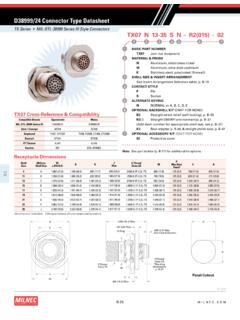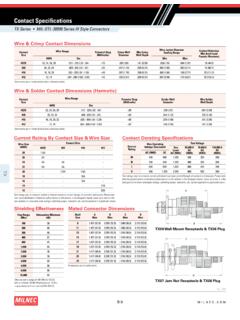Transcription of AN INTRO TO Wiring Harnesses
1 AN INTRO TO Wiring Harnesses An Introductory Guide for Engineers Designing Aircraft Wiring Harnesses January 1, 2014 John Ashour - President, InterConnect Wiring - A Publication of LOGO 1 TABLE OF CONTENTS Introduction Chapter 1 Wire Harness Design Where to Start? Chapter 2- Standard Versus Non-Standard Versus COTS Parts Chapter 3 Wire Selection Chapter 4 Wire Identification Chapter 5 Connector Selection Chapter 6 Reference Designators Chapter 7 Shield Termination Chapter 8 Harness Bundle Protection Chapter 9 Testing Chapter 10 Industry Standards Summary f t in g+ 2 Share this eBook Introduction The purpose of this eBook is to provide some general guidance to new aerospace engineers who are tasked in designing electrical Wiring Harnesses .
2 The emphasis is on military aircraft but many of the guidelines are also true for commercial aircraft. InterConnect is not aware of any similar document on this subject. Typically in the industry, each Original Equipment Manufacturer (OEM) makes their own guidelines and passes that information on to their engineers. Hopefully, over the years and after numerous comments and feedback from many design engineers this document can become an industry standard. f t in g+ 3 Share this eBook Introduction These guidelines are based on over 25 years experience in the industry and are what InterConnect has identified as best practices from OEM s such as: Lockheed Martin, The Boeing Company, Sikorsky Aircraft, Bell Helicopter, BAE, and the Joint Services Wiring Action Group (JSWAG).
3 No proprietary information is presented in this EBook. It contains only general information used throughout the military aerospace Wiring harness industry. The eBook covers the following topics in the order listed: Wire Harness Design Where to Start Standard Versus Non-Standard Parts Versus Commercial Off The Shelf (COTS) Parts Wire Selection Wire Identification Connector Selection Shield Termination Reference Designators Harness Bundle Protection Testing Industry Standards f t in g+ 4 Share this eBook CHAPTER 1 Wire Harness Design Where to Start So you are a new engineer freshly out of college. You get hired at a large OEM to design electrical Wiring Harnesses and wired box assemblies.
4 Not having the proper training in college you ask yourself, Where do I start? . The possibilities are limitless. Luckily you can do a Google search and find this eBook under InterConnect Wiring s home page. After a quick examination you download it and begin reading. Typically each aircraft has a specification called an Air Vehicle Specification (AVS). This is a very large document that the OEM writes prior to designing the aircraft. It includes tons of information about the aspects of an aircraft. Some of that information includes Wiring harness design. Ask an experienced engineer or your boss if there is an AVS or similar document.
5 If there is, get a copy, look through the table of contents and find and read sections that deal with electrical systems design. 5 The next piece of information you need is the Wiring harness military specification that most military aircraft comply with. This specification is SAE AS50881 (at one time it was MIL-STD-5088) Wiring Aerospace Vehicle . This specification covers information such as: wire current carrying capacity, how wires are identified, marked, routed, and supported in military aircraft, and hundreds of other necessary guidelines and requirements. Download a copy of this document, read it and keep it handy for further use.
6 You can find it at 6 CHAPTER 2 Standard Versus Non-Standard Versus COTS Parts During the Wiring harness design process, there are thousands of different part numbers to select from. You ask yourself, how do I decide which parts to select? The subsequent chapters in this eBook provide information on how to select parts. Prior to reading those chapters, it is important to understand the following topics: Standard Parts Non-Standard Parts COTS parts A standard part is a military part. It is controlled by the US military (typically the Navy in Philadelphia, PA). These parts are often called mil spec parts (short for military specification).
7 Many of these part numbers start with M which is short for military. An example: is M39029/4-110. This is a military contact part number that is inserted into contact cavities of military connectors. some military part numbers start with MS which stands for military specification. 7 Another example is MS3154 which is a backshell or strain relief for wires that enter a connector. Other prefixes include NAS which stands for National Aerospace Standard. An example is NAS514 which is a screw. There are other military part number prefixes but these are the most common for the Wiring harness design industry. Each military part number has a specification associated with it.
8 These specifications are available on-line at Since around the late 1990 s the control of the specification has been transferred from the US Navy to the Society of Automotive Engineers. One good thing about military parts is that they are common across many aerospace platforms ( many different aircraft). As an example an F-35 may use a M83723/72W1212N connector that is also used in a V-22, F-16, F-15, C-130, C-17, etc. They are very common in industry. In most cases, the US government only approves certain suppliers and manufactures who are listed on the Qualified Parts List (QPL) for a particular part number. 8 . A non-standard part is based on a military part but is slightly changed from the military specification.
9 As an example, an OEM such as Lockheed Martin may want to use a military connector in a bulkhead penetration. Because the depth of a bulkhead is a little bit thicker than the size of the military connector, Lockheed Martin designs a new connector based on the military connector but increases its size slightly so it can fit in the penetration. In this case, Lockheed Martin writes and controls a specification and gives the part a new part number. Typically an OEM will also designate which suppliers are approved to manufacture non-standard parts. The specification is typically called a Source Control Drawing or Specification Control Drawing.
10 The good thing about non-standard parts is that they fill a need for the OEM and the OEM controls the specification and the suppliers who can build them. The bad thing is that these parts are typically more expensive since fewer are required throughout the industry and in many cases are used on only one aircraft. 9 . The third category of parts is Commercial Off The Shelf (COTS). These parts are designed and controlled by a manufacturer. Based on the need for the items in the commercial and military industry and marketing studies, a manufacturer will design and make its own part numbers. The manufacturer controls revisions to the specification and when to release revisions.


